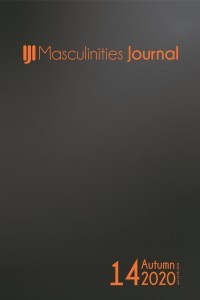Ötekileştirilen Siyahi Erkek: Afro-Amerikan Lezbiyen Erotik Kurgularda Erkeklik İmajı
Afro-Amerikan erkeklik, erotik kurgu, Afro-Amerikan kadınlık
The Othered Black Male: Images of Masculinity in African American Lesbian Erotic Fiction
African American masculinity, Erotic fiction,
___
- Alexandria, D. “One Mic.” Kuma2.net, 2005. Web. http://www.kuma2.net/lit/onemicpt20705.htm.
- Anderson, Elijah. Street Wise: Race, Class and Change in an Urban Community. Illinois: University of Chicago Press, 1991. Print.
- Blaaze. “One Helluva Night.” Kuma2.net, 2004. Web. www.kuma2.net/lit/onehelluvanight0904.htm.
- Cashazznjuice. “Collision Unleashed.” Kuma2.net, 2003. Web. http://www.kuma2.net/oldlit/collisionunleashed1203.htm.
- Collins, Patricia Hill. Black Sexual Politics: African Americans, Gender, and the New Racism. New York: Routledge, 2004. Print.
- ---. Black Feminist Thought: Knowledge, Consciousness and the Politics of Empowerment. New York: Routledge, 1993. Print. Masculinities Journal 51
- Dines, Gail. “The White Man’s Burden: Gonzo Pornography and the Construction of Black Masculinity.” Yale Journal of Law and Feminism, 18.1 (2006). 283-297. Print.
- EroticBrat. “Live 2 Dream.” Kuma2.net, 1998-2000. Web. http://www.kuma2.net/oldlit/live2d.htm.
- Glitter. “Blind Love.” Kuma2.net, 2002. Web. http://www.kuma2.net/oldlit/blindlovepart102.htm.
- ---. “Sex by Felicia 101.” Kuma2.net, 2002. Web. http://www.kuma2.net/oldlit/sexbyfelicia10103.htm.
- Goffman, Erving. The Presentation of Self In Everyday Life. New York: Doubleday, 1959. Print.
- Holmberg, Carol. Sexuality and Popular Culture: Foundations of Popular Culture. California: Sage, 1998. Print.
- hooks, bell. We Real Cool: Black Men and Masculinity. New York: Routledge, 2004. Print.
- ---. Reel to Real: Race, Sex and Class at the Movies. New York: Routledge, 1996. Print.
- ---. Outlaw Culture: Resisting Representations. New York: Routledge, 1994. Print.
- ---. Black Looks: Race and Representation. Boston: South End Press, 1992. Print.
- ---. Ain’t I A Woman: Black Women and Feminism. Boston: South End Press, 1981. Print.
- Infamous Trece. “I Always Get What I Want.” Kuma2.net, 2001. Web. http://www.kuma2.net/oldlit/alwaysget02.htm.
- Innes, Sherrie. Tough Girls: Women, Warriors and Wonder Women in Popular Culture. Pennsylvania: University of Pennsylvania Press, 1999. Print. Masculinities Journal 52
- InsatiableK. “Sunshine.” Kuma2.net, 2005. Web. http://www.kuma2.net/lit/sunshine0905.htm.
- Jackson II, Ronald. Scripting The Black Masculine Body: Identity, Discourse and Racial Politics in Popular Media. New York: State University of New York Press, 2006. Print.
- Jai. “Sweet Hellos and Goodbyes.” Kuma2.net, 2003. Web. www.kuma2.net/lit/sweethellosandgoodbyes0505.htm.
- Lil AJ. “Can You Stand the Rain?” Kuma2.net, 2002. Web. http://www.kuma2.net/oldlit/cystr103.htm.
- ---. “Distant Lover.” Kuma2.net, I2001. Web. http://www.kuma2.net/oldlit/distantlover.htm.
- Magubane, Zine. “Which Bodies Matter? Feminism, Poststructuralism, Race and the Curious Theoretical Odyssey of the ‘Hottentot Venus’.” Gender and Society 15.6 (2001). 816-834. Print.
- Majors, Richard and Janet Mancini Billson. Cool Pose: The Dilemmas of Black Manhood in America. New York: Touchstone, 1993. Print.
- Mayall, Alice and Diana E. H. Russell. “Racism in Pornography.” Making Violence Sexy: Feminist Views on Pornography. Ed. Diana E. H. Russell. New York: Teachers College Press, 1993. 167-178. Print.
- McNay, Lois. Foucault and Feminism: Power, Gender and the Self. Boston: Northeastern University Press, 1992. Print.
- Mohanni. “The Balcony and the Fireplace.” Kuma2.net, 2002. Web. http://www.kuma2.net/oldlit/thebalcony203.htm.
- Moore, Mignon R. Invisible Families: Gay Identities, Relationships and Motherhood Among Black Women. Berkeley: University of California Press, 2011. Print.
- Neal, Mark A. Looking for Leroy: Illegible Black Masculinities. New York: New York University Press, 2013. Print.
- Northcoastgirl. “A Good Story And An Even Better Plot.” Kuma2.net, 2003. Web. http://www.kuma2.net/oldlit/agoodstory03.htm. Masculinities Journal 53
- Oates, Thomas P. “The Erotic Gaze in the NFL Draft.” Communication and Critical/Cultural Studies, 4.1 (2007). 74-90. Print.
- Pompper, Donnalynn. “Masculinities, the Metrosexual and Media Images: Across Dimensions of Age and Ethnicity.” Sex Roles, 63 (2010). 682-696. Print.
- Quinn, Eithne. “‘Who’s the Mack?’:The Performativity and Politics of the Pimp Figure in Gangsta Rap.” Journal of American Studies, 324.1 (2000). 115-136. Print.
- Rich, Adrienne. “Compulsory Heterosexuality and Lesbian Existence.” Signs, 5.4 (1980). 631-660. Print.
- Rios, Victor. Punished: Policing the Lives of Black and Latino Boys. New York: New York University Press, 2011. Print.
- Rose, Tricia. The Hip Hop Wars: What We Talk About When We Talk About Hip Hop--and Why It Matters. New York: Perseus, 2008. Print.
- ---. Black Noise: Rap Music and Black Culture in Contemporary America. Connecticut: Wesleyan University Press, 1994. Print.
- Taneigha. “Discriminated.” Kuma2.net, 2003. Web. http://www.kuma2.net/oldlit/discriminated03.htm.
- Wallace, Maurice O. Constructing the Black Masculine: Identity and Ideality in African American Men’s Literature and Culture, 1775-1995. North Carolina: Duke University Press, 2002. Print.
- Ward, Elijah G. “Homophobia, Hypermasculinity and the U.S. Black Church.” Culture, Health and Sexuality, 7 (2005). 493-504. Print.
- West, Candace and Don H. Zimmerman. “Doing Gender.” Gender and Society, 1.2 (1987). 125-151. Print.
- West, Cornel. Race Matters. Massachusetts: Beacon Press, 1993. Print.
- Başlangıç: 2014
- Yayıncı: Eleştirel Erkeklik İncelemeleri İnisiyatifi
Ötekileştirilen Siyahi Erkek: Afro-Amerikan Lezbiyen Erotik Kurgularda Erkeklik İmajı
“Ucundan Azıcık”la Atılan Sağlam Temel: Türkiye’de Sünnet Ritüeli ve Erkeklik İlişkisi
Tehdit Edilmiş Erkeklikler: Ruanda Kırsalındaki Erkeklerin Toplumsal Cinsiyet Eşitliği Deneyimleri
“Drag”ler, Uyuşturucular ve Kir: Marilyn Manson’un Müzik Videosu “(s)Aint’’de Iğrenti ve Erkeklik
“Kızıl Ordu Söyleminde ve Öznelliğinde Militarist Erkeklikler, 1942-1943”
N. Gamze TOKSOY, Aysegul TASİTMAN
Erkek Millet, Asker Millet: Türkiye’de Militarizm, Milliyetçilik, Erkek(lik)ler
British Pronoun Use, Prescription and Processing
Gerçek Erkek Ayağa Kalkabilir mi Lütfen: Trans Erkeklerin Cinsiyetlendirilmiş Performansı
